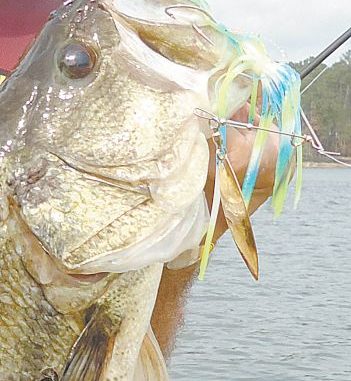
Blade colors, shapes and combinations are keys to getting the best bass action
Spinnerbaits are among the most-effective and most-popular lures that bass fishermen carry in their tackle boxes, especially in the spring. But they are also lures that present fishermen with all kinds of options in terms of sizes, colors and the size, shape and colors of the whirling, jangling blades that give them their fish appeal. And that presents fishermen with a lot of questions about which to use, and when.
Bass pro Davy Hite of Ninety Six, S.C., offers a few tips that will help anglers know which kinds of spinnerbait combinations to throw under some common spring conditions.
“Blade combinations are really important in terms of the colors and action of different blades,” said Hite, the 1999 Bassmaster Classic champion and a two-time BASS Angler of the Year. “You are thinking about vibration, lift and color.”
Hite said the three main types of blades — Colorado, Indiana and willow leaf — have different uses under different circumstances. The tear-drop shaped Colorado is cupped and provides plenty of vibration; the willow leaf (it looks like its name) provides lift, and the Indiana has a combination of both.
“You want to use blades that give off a lot of vibration for dirty water and low-light situations — like early morning or cloudy days,” he said. “You also want a blade with a lot of vibration when you’re going to be fishing it slowly, slow-rolling it. The more the blade thumps, the slower you can work it and the easier it is to feel the blade.
“The Colorado has the most vibration, the Indiana is second and the willow leaf is third.”
Lift, according to Hite, helps bring the bait to the surface, and the willow leaf provides the most lift, with the Indiana second and Colorado bringing up the rear.
“You need to think of the lift a blade provides when you’re going to fish a blade higher in the water column,” he said. “The best combination in that situation will be twin willow-leaf blades.
“All of the blades can be used in combinations with each other depending on how much vibration and lift you need. If you had to pick one combination, a Colorado blade in front of a willow-leaf blade would be it.”
Hite likes to use bright, colored blades when he’s fishing dirty water.
“Painted blades seem to really show up in dirty water,” he said. “I like to fish anything painted a bright color: orange, red, chartreuse or white.”
In clearer water, the choice is between gold and silver (nickel) blades.
“Early in the year, when the water’s colder and you want to fish the bait slower — and when there are more crawfish around — you want to fish gold blades,” he said. “Later in the year, when you’re fishing around a lot of shad or you want to fish the bait high in the water color, you fish silver. You want to fish gold when you’re fishing more around bluegill.”
Hite said that those styles and colors of blades will usually match any condition an angler might face. He said he occasionally fishes a blade that’s hammered and not plain when he’s fishing under windy conditions and needs a little more flash. He uses chartreuse or white heads — or a combination of the colors — 95 percent of the time. Once in a great while, he’ll use a War Eagle model that comes with a gold-plated head for a little more flash.


